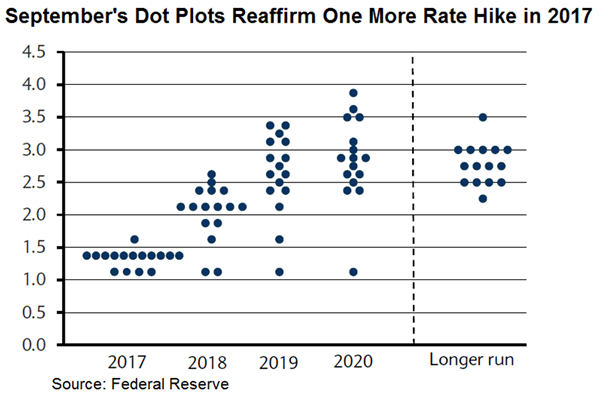The Fed finally made formal announcement that it would begin normalizing the balance sheet in October. As indicated in June, the process does not involve active selling of securities, but a passive run-off of its holdings. The policy rate also stayed unchanged at 1-1.25%. The overall tone of the statement and the press conference came in more hawkish than expected. Depsite downward revision in the core CPI for this year, the staff upgraded the economic growth outlook and downgraded the unemployment rate forecast. The median dot plot continued to project one more rate hike this year, followed by three more increases in 2018. As CME’s 30-day Fed funds futures suggested, bets for a December hike markedly jumped to 73.4% from 57.7% in the prior day.
As a recap of the plan announced in June, the Fed has set the cap at US$10B/ month initially. That is, the caps start for the first three months at US$6B and US$4B for Treasuries and MBS respectively, before rising each quarter until they reach US$30B and US$20B per month Treasuries and MBS respectively, by October 2018.
Despite subdued inflation, the Fed remained firm on raising the policy rate. The median dot plot showed little change from June’s. 4 of out the 16 members favored leaving the policy rate unchanged for the rest of the year. Yet, 11 members believed one more hike is appropriate, whilst one opted for two more hikes. For 2018, the median participant favored three rate hikes, whereas 5 members preferred fewer, compared with 4 in June. The above results suggested that the majority of members viewed the current weak inflation as transitory. However, Chair Janet Yellen noted that the committee’s ‘understanding of the forces driving inflation is imperfect and in light of the unexpected lower inflation readings this year, the committee is monitoring inflation developments closely’. She added that if the inflation shortfall does prove persistent then ‘it will be necessary to adjust monetary policy to address that’.
On the economic outlook, the staff revised lower the core PCE inflation for this year and 2018 to +1.5% (June: +1.7%) and +1.9% (June: +2%), respectively. Forecasts for 2019 and 2020 stayed unchanged at 2%. However, the Fed has turned more upbeat over the economic environment otherwise. GDP growth is upgraded to +2.4% for this year, up from +2.2% previously, while the unemployment rate is revised lower to 4.1% for both 2018 and 2019 (June: 4.2%). The impacts of a number of hurricanes appeared limited. According to the Fed, although Hurricanes Harvey, Irma, and Maria would put some near-term pressure on growth and upward pressure on inflation in the near-term, the storms are ‘unlikely to materially alter the course of the national economy over the medium term’.
The overall tone signaled that the Fed is committed to carry on the rate hike schedule (three increases for 2017) as indicated earlier this year. Barring a ‘material’ change in the economic outlook, the Fed should implement its rate hike and balance sheet normalization policies any planned.














